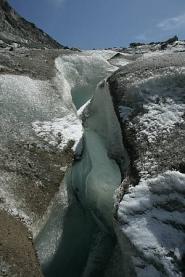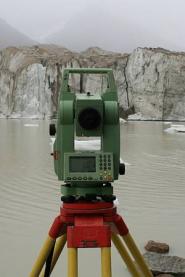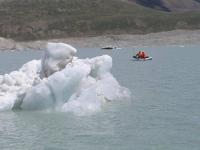PROJECT 2004-2007
KYRGYZSTAN - Monitoring of alpine glacial lakes and protection of the local population from the impacts of severe floods caused by failure of moraine dams
Administrative body: Ministry of Environment of the Czech Republic
Technical supervisor: RNDr. Josef Janda
Contractor: GEOMIN družstvo, Jihlava
Project manager: RNDr. Michal Černý
Co-operating institutions: Department of Physical Geography and Geoecology, Faculty of Science, Charles University
Counterpart organization in the Kyrgyz Republic: State Agency for Geology and Mineral Resources, Sergej Alexandrovič Jerochin
Co-operating organization in the Kyrgyz Republic:Ministry of Emergency, Academy of Science of the Kyrgyz Republic, Kyrgyz-Russian Slavonic University
The project is funded from the budget of the Czech Republic within the program of Czech Technical Development Cooperation
Project budget: A total of CZK 9 150 000
Project research schedule: project implementation in the years 2004 - 2006
BACKGROUND INFORMATION
The danger from alpine lakes is growing because of global warming arising from disturbances of the climate of the Earth. Numerous glacial lakes have formed due to progressive and accelerated thawing of glaciers. The lifetime of the majority of lakes is mostly a few tens of years and the level of water in them oscillates widely during particular years. When the underground channels draining these lakes are blocked by glacial sediments, the water level rises rapidly, often leading to the catastrophic failure of poorly stabilized moraine dams followed by dangerous floods. The development of glacial lakes and their dynamics have accelerated during the last two decades. The risks of flooding are amplified by greater ranges in temperature and atmospheric precipitation during single years and by increases in the annual totals.
The hazards due to outbursts of water from alpine lakes exist in all high mountain regions in Europe, Asia and in North and South America. In the last decades much attention has been paid to this problem by researchers. Since 1966, these phenomena have been the subject of systematic study in the Kyrgyz Republic. Catastrophic failures are recorded almost every year. The most severe failure occurred at Shakhimardan lake in 1998. This caused extensive economic damage and the almost one hundred people in the territory of Kirghizia and Uzbekistan were killed in the disaster. About 8 200 glaciers covering more than 8 000 km2 are documented in the Kyrgyz republic. They cover some 4.2 % of the total surface area of the territory. It is estimated that the glaciers hold 650 x 109 m3 of water. The effects of global warming and other ecological factors such as pollution of the glacier surfaces by fallout from industrial emissions that reduce the albedo and cause greater absorption of solar radiation have led to progressively faster thawing of the glaciers. It is anticipated that in the period 2001 – 2025 the area of Kirghiz glaciers will be reduced by 30 – 40 %.
At present, about 50 000 alpine glacial lakes are known in the Kyrgyz Republic and more lakes are forming each year due to the melting of glaciers. The lakes are of various sizes and volumes from small thermokarst lakes of only a few tens of cubic meters in volume up to the Petrova lake having a capacity of 23 million cubic meters of water and an area of 278 hectares. Altogether, 278 lakes were identified as lakes showing risks of dam failure, based on investigations carried out so far. Of these, 63 lakes are predicted to fail within the next few years. These were briefly cataloged, their capacity estimated and the degree of danger established on a scale of 1-3. About 20 lakes are in imminent danger of failure. The joint Czech-Kyrgyz project was designed and submitted at the request of the Kyrgyz partners in 2003, and accepted in the same year as a bipartite project within the program of CzechTechnical Aid to Developing Countries. The field work began in the summer of 2004.
PROJECT OBJECTIVES
Developmental goal of the project
-
The project is designed to provide technical assistance in studying the damming of alpine lakes that are in imminent danger of bursting.
-
The intention of the project is to improve safety in the development of mountainous regions in the Kyrgyz Republic so that the settlements situated in mountain valleys will be protected from flood waters. The result should be more efficient planning of infrastructure and settlement, making the parallel development of recreation facilities and other social facilities possible.
-
The assessment of the degrees of risk linked to individual factors in the development of dammed glacial lakes will enable local administrative bodies to plan safety strategies for protection of the settlements in the valleys below and determine the optimum long-term program for economic and social development of mountain valleys.
Immediate aims of the project
-
Acquisition of database for monitoring and predicting the evolution of glacial lakes and the behavior of moraine barriers, strengthening dams and constructing flumes to allow controlled drainage
-
Continuous monitoring of the state of dangerous alpine lakes in connection with global warming and climate change and changes in glacier morphology due to recession
-
Assessment of the danger from individual lakes by investigating mechanisms of recent and possible future failures using computer modeling, taking into account the type of the lake, the geomorphology of the valley and population density
Project area
The activities of the project will be focused on the mountain ranges of the western Tian Shan in the northern part of the Kyrgyz Republic. The processes of glacier development and recession have been accelerating fast during the last decades. This has led to the formation of numerous new glacial lakes, the failure of which could pose a great danger to local communities. The settlements in the valleys leading from the mountain slopes and on the shores of Lake Issik-Kul support a dense population that is particularly vulnerable to any failure of moraine dammed lakes in the hinterland. Flooding is likely to cause casualties and severe disruption to the local economy.












